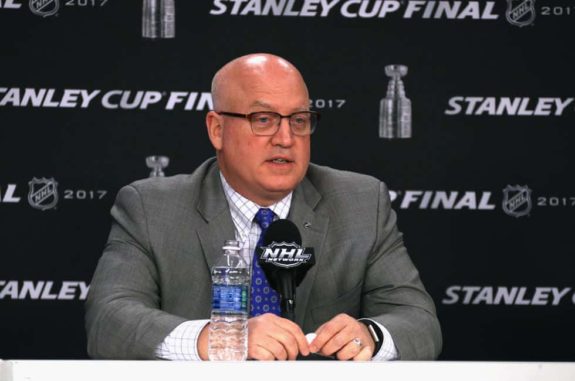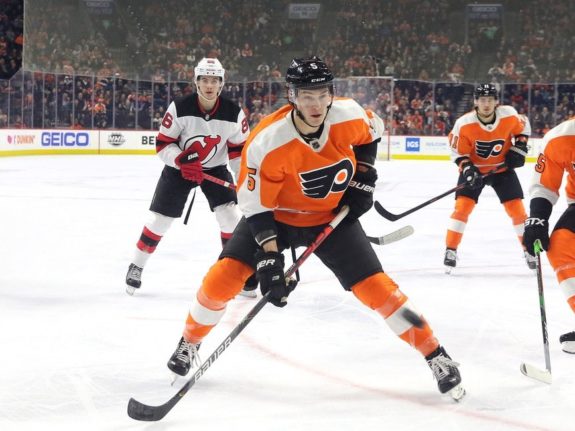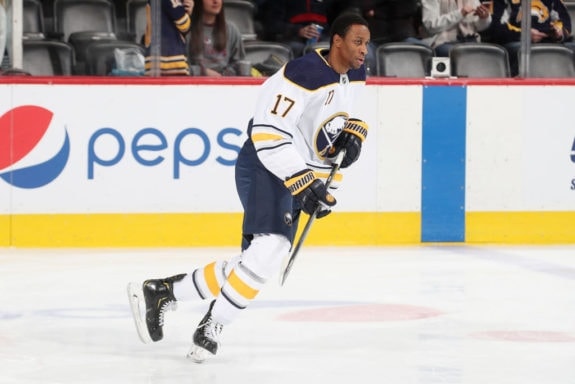Over the years, the NHL has evolved in adding speed and talent to grow the sport. Hockey constantly thrusts itself into the debate as one of the most grueling and enduring sports. However, the slim pay scale on which the league’s salary cap is constructed has limited teams like the Philadelphia Flyers from rewarding their players financially.
Related: Flyers’ All-Decade Team
On March 4, 2020, deputy commissioner Bill Daly announced an increase in the salary cap jumping from $81.5 million to $84 million, a major boost for all teams.
Players Score Pay Day
The $2.5 million increase is set to take effect for the 2020-21 season. The NHLPA also has a say in a possible five percent inflation rate that would bring the salary cap up from $84 million to $88.2 million according to their Collective Bargaining Agreement. If the Player’s Association elects to use that five percent, it will beef up contracts with more money guaranteed through signing bonuses.

This cap increase serves as a chance for clubs to get creative and go after high caliber players who normally wouldn’t fit inside their budget. A team like the Flyers is one to keep an eye on.
What It Means for the Flyers
In 2019-20 the NHL cap limit was $81.5 million, a number Flyers general manager Chuck Fletcher has successfully used to lock up his impressive core. With 48 of 50 players inked to contracts, including players on the Flyers’ roster and in their minor league system as of this season, the organization has the sixth-highest projected cap hit in the league with $82.7 million spent. With all but two players signed and a cap increase on the way, club management can breathe a sigh of relief.
Fletcher has done an incredible job of rewarding his players while towing the cap line. In the past year, he signed three noteworthy pieces to multi-year deals that will keep them in the orange and black for the foreseeable future: defenseman Ivan Provorov, and forwards Kevin Hayes and Travis Konecny. Despite his spending, Fletcher has prepared the Flyers for the future without selling the farm.
Related: Revisiting the Brayden Schenn Trade
With $2.6 million available, tough decisions could turn into easy ones as the Flyers’ cap space skyrockets to $14.4 million heading into the 2020-21 season. The big number comes from active contracts coming off the books heading as well as the cap increase.
Newer additions through offseason trades, like forward Tyler Pitlick and defenseman Justin Braun, will see their contracts expire after this season. Pitlick comes at a cheap price with a $1 million cap hit, but Braun alone carries a $3.8 million cap hit stemming from his contract with the San Jose Sharks. Having said that, Pitlick and Braun are worth a serious look during contract negotiations due to their underrated productivity. Then there are crucial depth players like forwards Scott Laughton and Michael Raffl, who will also become unrestricted free agents in 2022. The two have a combined cap hit of $4.8 million.

Other ascending stars to keep in mind are restricted free agents Robert Hagg, Philippe Myers, Nolan Patrick, Oskar Lindblom, and Nicolas Aube-Kubel. The Flyers have first dibs on striking a deal based on their cap hit in 2020-21.
However, there are technicalities within these contracts. For example, Aube-Kubel is eligible for arbitration, which means a third party arbitrator can sit in on negotiations to determine fair terms if he wants. As for Patrick and Lindblom, they are on the Flyers’ long-term injured reserve list, which preserves a year of eligibility if they come back after the league’s pause due to the coronavirus pandemic.
If the Flyers are unsuccessful in re-signing these players, notable upcoming free agents like Wayne Simmonds could be a target in a return to Philly. While keeping the team’s nucleus intact, Simmonds’ $5 million cap hit, would put a familiar face in that big-bodied depth role while also contributing on the power play.
Another popular name is right-winger Tyler Toffoli, who is wrapping up his final year on his contract. He was traded from the Los Angeles Kings to the Vancouver Canucks at this year’s trade deadline when he was also linked to Flyers trade rumors. The right-handed sniper brings a cap hit of $4.6 million, a relatively cheap price for a consistent and versatile player.

The Flyers are loaded with blue line talent in their system, so they could focus on finding a backup goalie to complement their phenom backstop, Carter Hart, as a second line of defense. Journeyman goaltender Brian Elliot has slotted perfectly into that role, but age may be the deciding factor in letting the 35-year-old explore free agency.
Financial flexibility has the Flyers in the driver’s seat, as a team to watch moving forward. A splash in acquiring an elite forward this offseason is possible to bolster the club’s fast-paced offense. For now, look for Fletcher to stick to the status quo. With plenty of money to play with, his priority will be to restructure contracts and reflect on possible extensions.